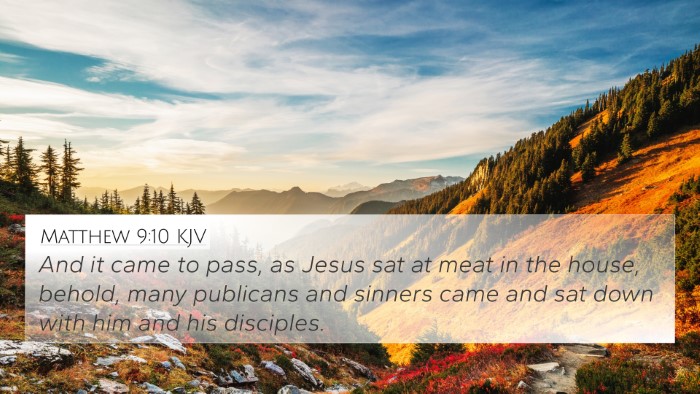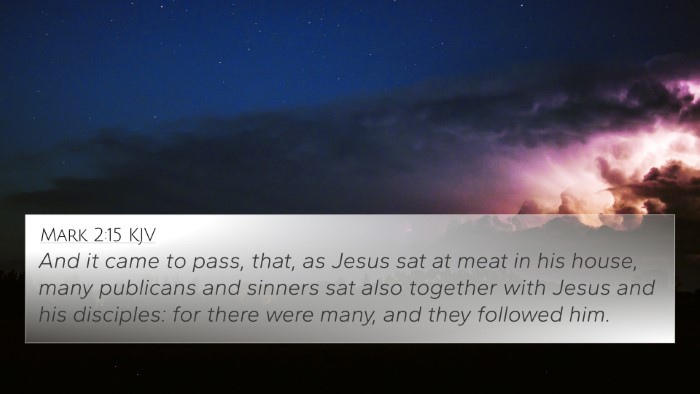Understanding Luke 5:29
Luke 5:29: "Then Levi held a great banquet for Jesus at his house, and a large crowd of tax collectors and others were eating with them."
Summary of Meaning
This verse depicts an important event in the ministry of Jesus, highlighting themes of acceptance, transformation, and the nature of Jesus’ mission. Levi, who is also known as Matthew, invites Jesus into his home, signaling a shift from a life of sin to one of discipleship.
Insights from Commentaries
-
Matthew Henry:
Henry emphasizes the significance of Jesus’s company with sinners. It showcases His mission to call not the righteous, but sinners to repentance (Luke 5:32). He points out that Levi’s transformation is reflected in his actions, choosing to host Jesus and others at a banquet, thereby indicating joy and acceptance of the new teaching.
-
Albert Barnes:
Barnes discusses how Levi's banquet represents a celebration of a new life and commitment to Christ. He states that Levi was eager to share his newfound faith with others who were like him, demonstrating an important aspect of Christian conversion: the desire to influence others toward faith.
-
Adam Clarke:
Clarke notes that this social gathering contained significant symbolism regarding Jesus’ role in society. The act of dining with tax collectors and sinners contradicted the Pharisaical traditions of separation, illustrating the revolutionary nature of Christ’s ministry in reaching those marginalized by religious norms.
Connections with Other Scriptures
Luke 5:29 can be understood through various cross-references that provide additional context. Here are some notable connections:
- Matthew 9:10-13: Similar to Luke 5:29, this passage describes Jesus dining with sinners and the criticism He faces from the Pharisees, affirming His mission.
- Mark 2:15-17: This account parallels the story in Luke, reinforcing Jesus' approach to those marginalized in society.
- Luke 15:1-2: Highlights Jesus receiving sinners and eating with them, further developing the narrative of His welcoming nature.
- Luke 19:10: Jesus states His mission: "For the Son of Man came to seek and to save the lost," aligning with the theme of reaching out to tax collectors.
- 1 Corinthians 5:9-10: Paul discusses associating with sinners for the sake of witness, aligning with the principles exemplified by Jesus in this passage.
- John 3:17: Affirms that Jesus did not come to condemn the world but to save it, reflecting the heart of His ministry.
- Romans 5:8: Describes God's love as unconditional, exemplifying the acceptance seen in Luke 5:29.
Interpretation and Application
The implications of Luke 5:29 are profound for modern Christians. It invites believers to:
- Embrace the Marginalized: Just as Jesus did, Christians are called to reach out to those often excluded by society.
- Reflect on Personal Transformation: Levi's change after meeting Jesus urges self-examination of spiritual growth.
- Celebrate Faith: Hosting gatherings that reflect one's faith promotes community and fellowship among believers and seekers.
Tools for Further Study
For a deeper analysis of Luke 5:29 and similar passages, consider the following tools:
- Bible Concordance: Utilize a concordance to locate related verses efficiently.
- Bible Cross-Reference Guide: Engage with guides designed to help find scripture connections.
- Cross-Reference Bible Study: Techniques focused on exploring thematic links between passages.
Conclusion
Luke 5:29 serves as a powerful reminder of Jesus’ mission to seek and save the lost. By evaluating connections between various scripture passages, we gain a holistic view of God’s plan for humanity. This narrative not only sheds light on the heart of Christ but also provides a model for how Christians ought to navigate relationships with the world around them.








